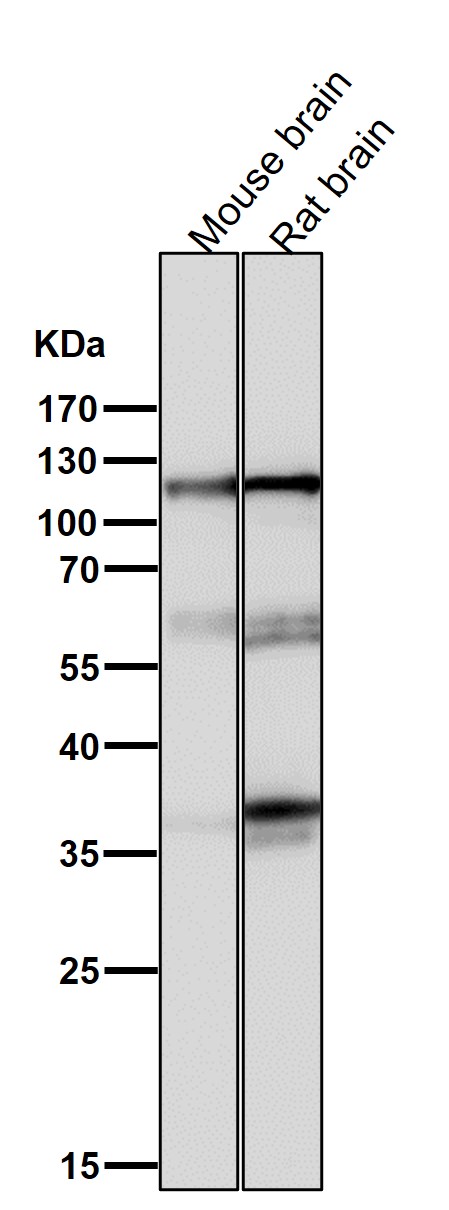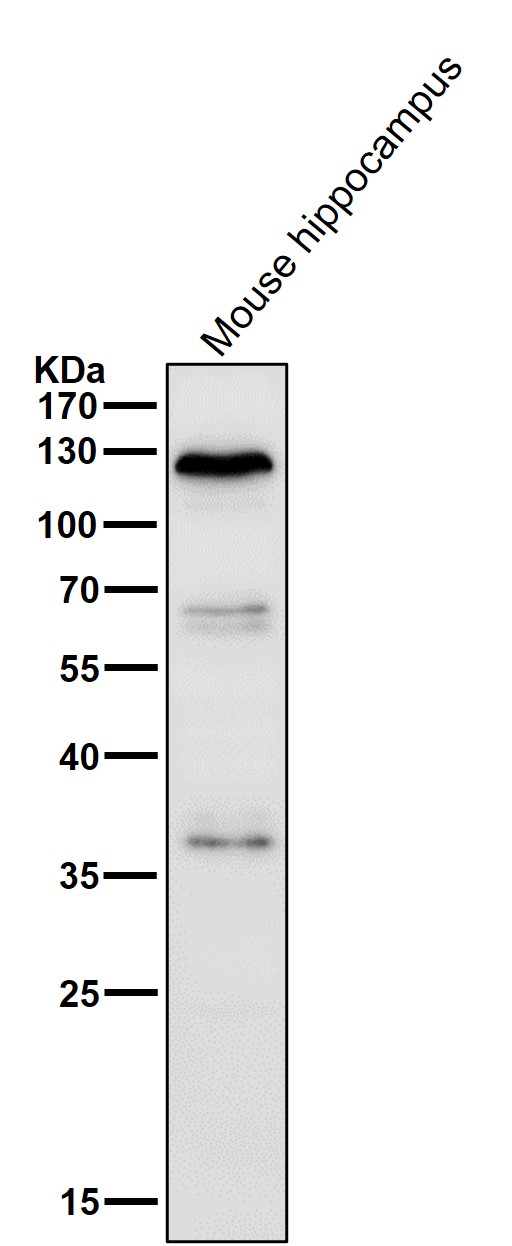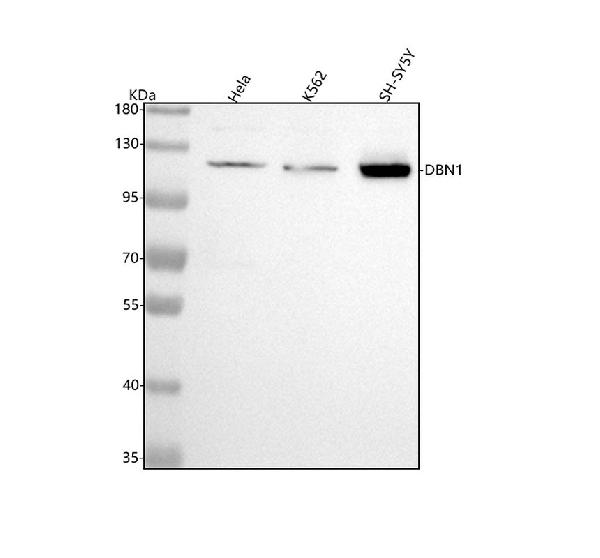Anti-Drebrin DBN1 Rabbit Monoclonal Antibody
- SPECIFICATION
- CITATIONS
- PROTOCOLS
- BACKGROUND

Application
| WB, IF, ICC, IP |
|---|---|
| Primary Accession | Q16643 |
| Host | Rabbit |
| Isotype | Rabbit IgG |
| Reactivity | Rat, Human, Mouse |
| Clonality | Monoclonal |
| Format | Liquid |
| Description | Anti-Drebrin DBN1 Rabbit Monoclonal Antibody . Tested in WB, ICC/IF, IP applications. This antibody reacts with Human, Mouse, Rat. |
| Gene ID | 1627 |
|---|---|
| Other Names | Drebrin, Developmentally-regulated brain protein, DBN1, D0S117E |
| Calculated MW | 71429 MW KDa |
| Application Details | WB 1:500-1:2000 ICC/IF 1:50-1:200 IP 1:50 |
| Subcellular Localization | Cytoplasm. Cytoplasm, cell cortex. Cell junction. Cell projection. Cell projection, growth cone. In the absence of antigen, evenly distributed throughout subcortical regions of the T-cell membrane and cytoplasm. In the presence of antigen, distributes to the immunological synapse forming at the T-cell-APC contact area, where it localizes at the peripheral and distal supramolecular activation clusters (SMAC) (PubMed:20215400). Colocalized with DBN1, RUFY3 and F-actin at the transitional domain of the axonal growth cone (By similarity).. |
| Tissue Specificity | Brain neurons. Also found in the heart, placenta, skeletal muscle, kidney and pancreas. Expressed in peripheral blood lymphocytes, including T-cells (at protein level).. |
| Contents | Rabbit IgG in phosphate buffered saline, pH 7.4, 150mM NaCl, 0.02% sodium azide and 50% glycerol, 0.4-0.5mg/ml BSA. |
| Clone Names | Clone: ABDC-4 |
| Immunogen | A synthesized peptide derived from human Drebrin |
| Purification | Affinity-chromatography |
| Storage | Store at -20°C for one year. For short term storage and frequent use, store at 4°C for up to one month. Avoid repeated freeze-thaw cycles. |
| Name | DBN1 |
|---|---|
| Synonyms | D0S117E |
| Function | Actin cytoskeleton-organizing protein that plays a role in the formation of cell projections (PubMed:20215400). Required for actin polymerization at immunological synapses (IS) and for the recruitment of the chemokine receptor CXCR4 to IS (PubMed:20215400). Plays a role in dendritic spine morphogenesis and organization, including the localization of the dopamine receptor DRD1 to the dendritic spines (By similarity). Involved in memory-related synaptic plasticity in the hippocampus (By similarity). |
| Cellular Location | Cytoplasm. Cell projection, dendrite. Cytoplasm, cell cortex. Cell junction. Cell projection, growth cone {ECO:0000250|UniProtKB:Q9QXS6}. Note=In the absence of antigen, evenly distributed throughout subcortical regions of the T-cell membrane and cytoplasm (PubMed:20215400). In the presence of antigen, distributes to the immunological synapse forming at the T-cell-APC contact area, where it localizes at the peripheral and distal supramolecular activation clusters (SMAC) (PubMed:20215400). Colocalized with RUFY3 and F-actin at the transitional domain of the axonal growth cone (By similarity) {ECO:0000250|UniProtKB:Q9QXS6, ECO:0000269|PubMed:20215400} |
| Tissue Location | Expressed in the brain, with expression in the molecular layer of the dentate gyrus, stratum pyramidale, and stratum radiatum of the hippocampus (at protein level) (PubMed:8838578). Also expressed in the terminal varicosities distributed along dendritic trees of pyramidal cells in CA4 and CA3 of the hippocampus (at protein level) (PubMed:8838578). Expressed in pyramidal cells in CA2, CA1 and the subiculum of the hippocampus (at protein level) (PubMed:8838578) Expressed in peripheral blood lymphocytes, including T-cells (at protein level) (PubMed:20215400). Expressed in the brain (PubMed:8216329, Ref.2). Expressed in the heart, placenta, lung, skeletal muscle, kidney, pancreas, skin fibroblasts, gingival fibroblasts and bone-derived cells (Ref.2) {ECO:0000269|PubMed:20215400, ECO:0000269|PubMed:8216329, ECO:0000269|PubMed:8838578, ECO:0000269|Ref.2} |

Thousands of laboratories across the world have published research that depended on the performance of antibodies from Abcepta to advance their research. Check out links to articles that cite our products in major peer-reviewed journals, organized by research category.
info@abcepta.com, and receive a free "I Love Antibodies" mug.
Provided below are standard protocols that you may find useful for product applications.
If you have used an Abcepta product and would like to share how it has performed, please click on the "Submit Review" button and provide the requested information. Our staff will examine and post your review and contact you if needed.
If you have any additional inquiries please email technical services at tech@abcepta.com.













 Foundational characteristics of cancer include proliferation, angiogenesis, migration, evasion of apoptosis, and cellular immortality. Find key markers for these cellular processes and antibodies to detect them.
Foundational characteristics of cancer include proliferation, angiogenesis, migration, evasion of apoptosis, and cellular immortality. Find key markers for these cellular processes and antibodies to detect them. The SUMOplot™ Analysis Program predicts and scores sumoylation sites in your protein. SUMOylation is a post-translational modification involved in various cellular processes, such as nuclear-cytosolic transport, transcriptional regulation, apoptosis, protein stability, response to stress, and progression through the cell cycle.
The SUMOplot™ Analysis Program predicts and scores sumoylation sites in your protein. SUMOylation is a post-translational modification involved in various cellular processes, such as nuclear-cytosolic transport, transcriptional regulation, apoptosis, protein stability, response to stress, and progression through the cell cycle. The Autophagy Receptor Motif Plotter predicts and scores autophagy receptor binding sites in your protein. Identifying proteins connected to this pathway is critical to understanding the role of autophagy in physiological as well as pathological processes such as development, differentiation, neurodegenerative diseases, stress, infection, and cancer.
The Autophagy Receptor Motif Plotter predicts and scores autophagy receptor binding sites in your protein. Identifying proteins connected to this pathway is critical to understanding the role of autophagy in physiological as well as pathological processes such as development, differentiation, neurodegenerative diseases, stress, infection, and cancer.





